|
|
||
|
27 February 2024 |
||
|
- Representative Concentration Pathways (RCPs) by IPCC
- Large Language Models (LLMs)
- Bitcoin Halving: A Quadrennial Crypto Marvel
- Household Consumption Expenditure Survey (HCES)
- Theyyam Performance Art of Kerala
- Baleen Whales

- Representative Concentration Pathways (RCPs) by IPCC
Understanding Representative Concentration Pathways (RCPs)
- The concept of RCPs, integral to climate modeling and forecasting, was introduced in the Fifth Assessment Report (AR5) of the IPCC in 2014.
- These pathways delineate potential trajectories of greenhouse gas and aerosol emissions stemming from human activities over time.
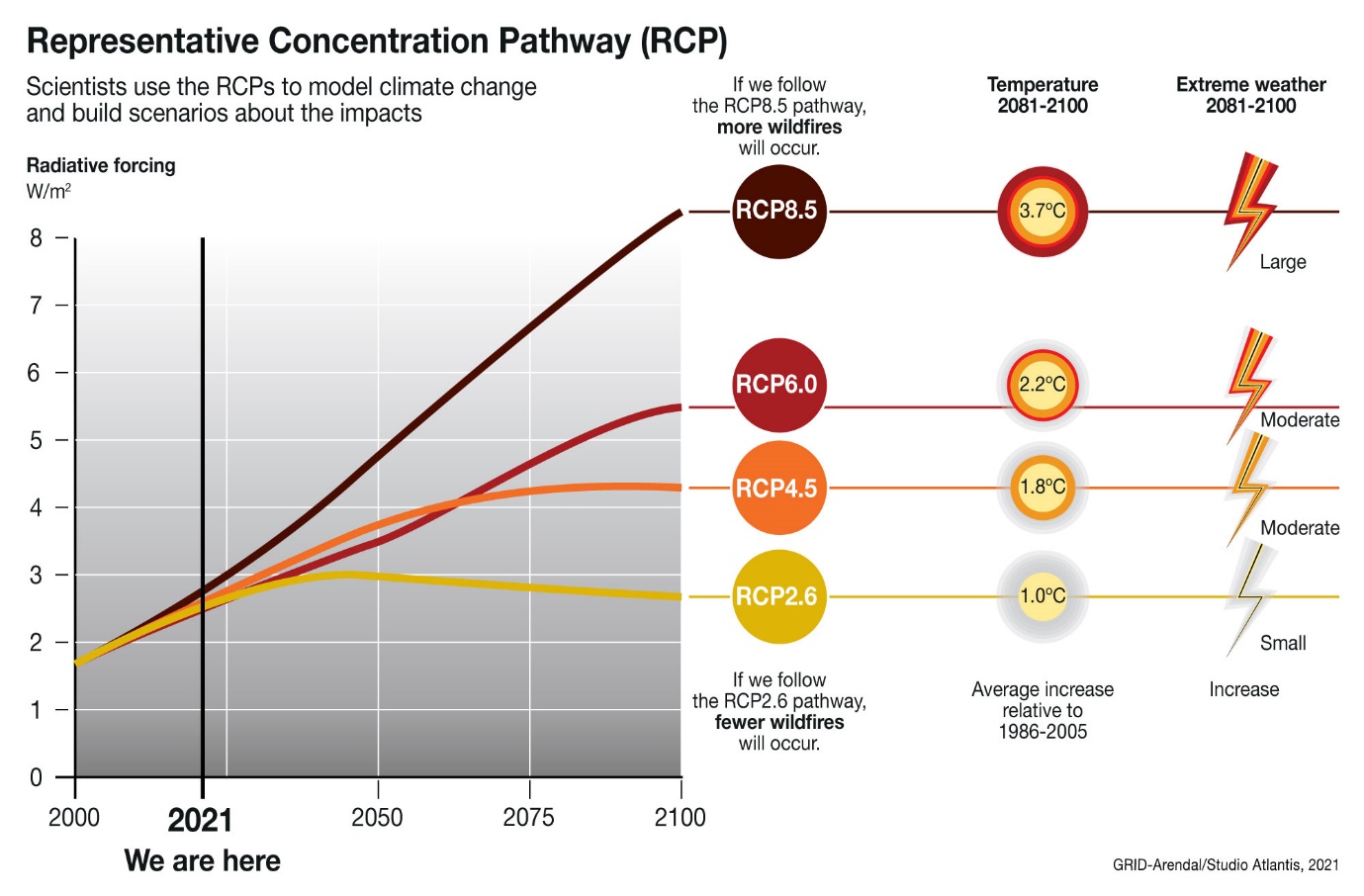
RCP Categories and Scenarios
- RCPs offer a set of scenarios categorized based on their total radiative forcing levels projected for the year 2100.
- They provide insights into various climate change scenarios contingent upon the levels of greenhouse gas emissions.
Exploring the RCP Scenarios
1. RCP 2.6: Aiming to limit global warming to less than 2°C above pre-industrial levels while mitigating ocean acidification, this scenario requires significant reductions in greenhouse gas emissions compared to current levels.
2. RCP 4.5: Positioned as an intermediate scenario, emissions under RCP 4.5 peak around 2040 before gradually declining. By 2100, this trajectory forecasts a global mean temperature rise of approximately 2°C above pre-industrial levels.
3. RCP 6: This scenario aims to stabilize radiative forcing at 6 watts per square meter (W/m²) post-2100, following a peak around mid-century.Although striving for a lower degree of global warming, temporary exceedances beyond the 2°C threshold may occur.
4. RCP 8.5: Characterized by continuous radiative forcing escalation throughout the century, RCP 8.5 portrays a high-emission scenario. By the end of the century, it predicts a global mean temperature increase exceeding 4°C above pre-industrial levels.
- Large Language Models (LLMs)
Introduction
The advent of generative AI, exemplified by platforms like OpenAI’s ChatGPT, has ignited extensive discourse on the capabilities of artificial intelligence, enabling computers to learn, reason, and interact.
At the core of this technological advancement are Large Language Models (LLMs), which empower computers to comprehend and produce text akin to human language.
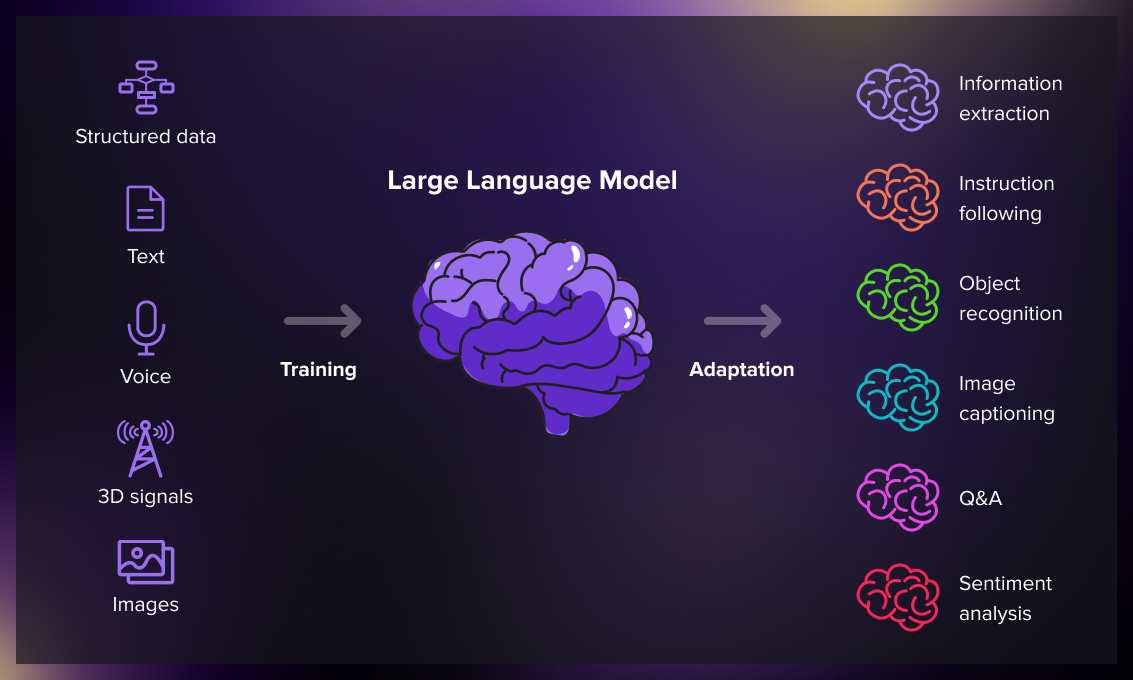
Understanding Large Language Models
- LLMs, as described by Google, represent expansive language models adept at addressing various linguistic challenges through rigorous training processes.
- These models undergo training on extensive datasets and possess the capability to handle diverse language-related tasks across multiple domains.
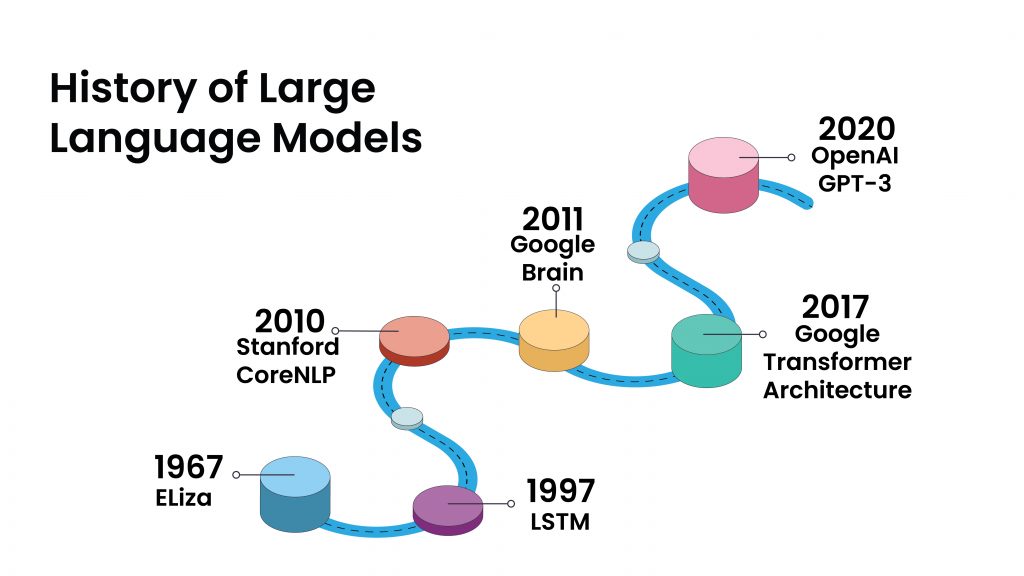
Key Attributes of LLMs
1. Scale: LLMs are trained on vast datasets and characterized by numerous parameters that dictate their functionality.
2. Universality: They exhibit the capacity to address a broad spectrum of language tasks, irrespective of specific subject matters or resource constraints.
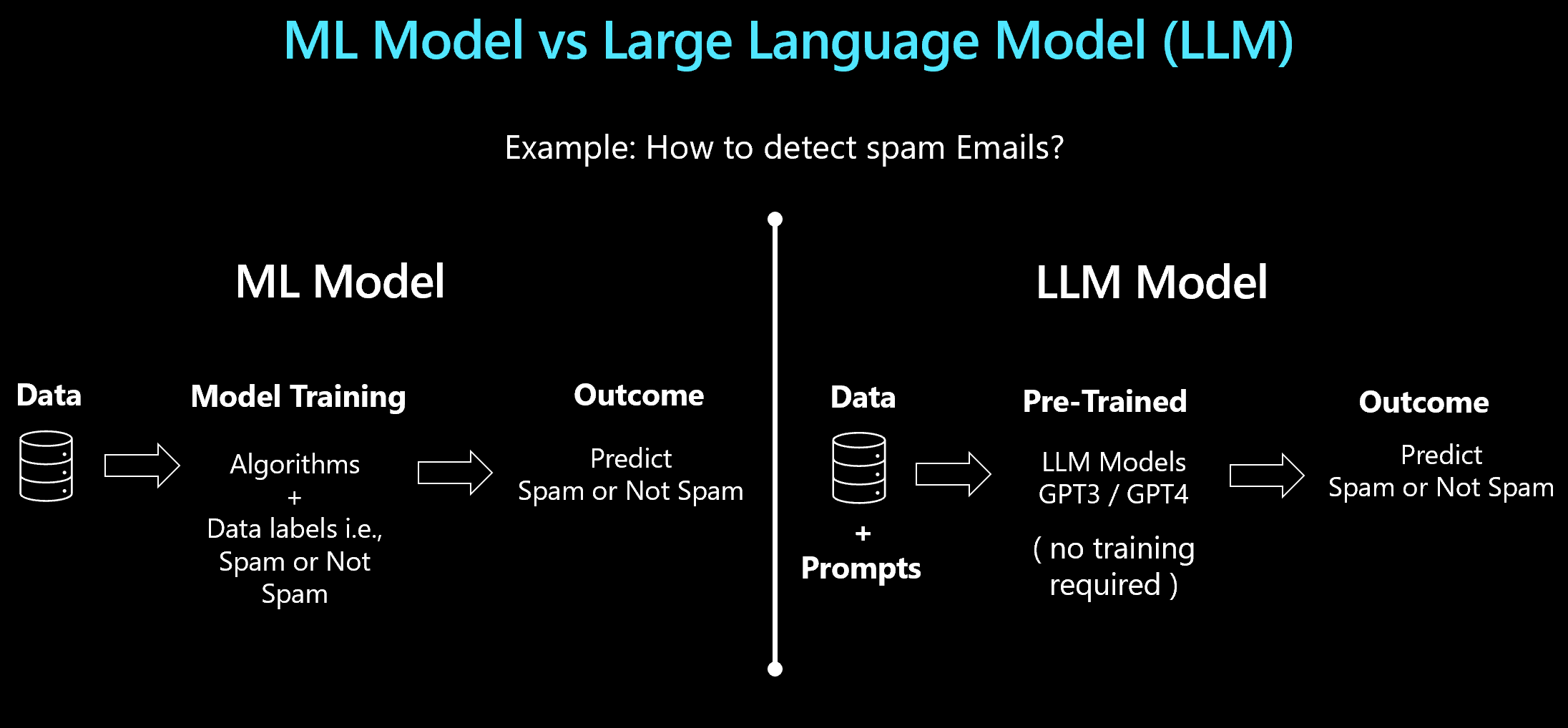
Variants of LLMs
- LLMs exhibit diverse architectures tailored to specific linguistic tasks, along with different methodologies for training, including domain-specific or multilingual approaches.
- Additionally, they vary in terms of size and accessibility, with certain models being openly available while others remain proprietary.
Functionality of LLMs
- Utilizing deep learning methodologies such as artificial neural networks, LLMs predict subsequent words or sequences based on prior inputs.
- Analogous to the language acquisition process in infants, LLMs discern patterns within data to make predictive inferences.
Applications of LLMs
- LLMs find utility across a spectrum of applications, including text generation, conversational interfaces, translation services, and summarization tasks.
- They play a pivotal role in content creation, marketing endeavors, and virtual assistance platforms.
Advantages Offered
1. Adaptability: LLMs demonstrate versatility in handling diverse tasks owing to their comprehensive understanding of language.
2. Generalization: They can extrapolate learned patterns to novel problems, even when confronted with limited information.
3. Iterative Enhancement: Through continuous exposure to data and refinement of parameters, LLMs exhibit ongoing improvement, ensuring their evolution over time.

- Bitcoin Halving: A Quadrennial Crypto Marvel

Bitcoin Halving
Every four years, the cryptocurrency community eagerly anticipates the Bitcoin halving, much like the excitement of the Olympics. Set for April, this event is a significant moment in Bitcoin mining and trading.
Understanding Bitcoin
- Bitcoin, introduced in 2009 by an anonymous entity known as Satoshi Nakamoto, is a digital currency operating on a decentralized blockchain ledger.
- This ledger records all transactions, ensuring transparency and security within the Bitcoin network.
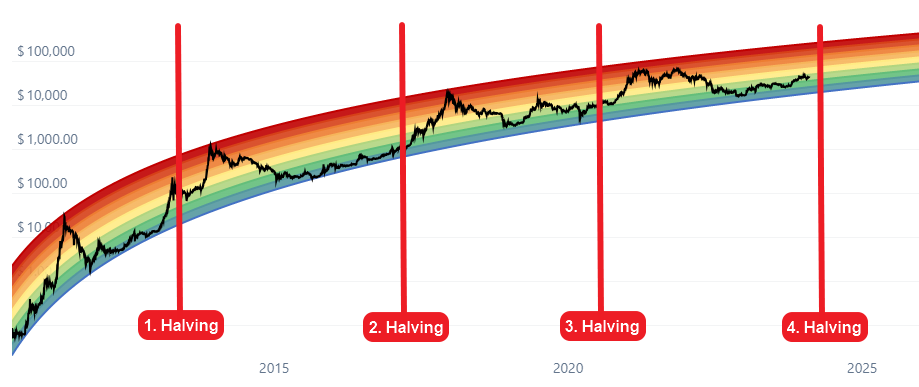
Bitcoin Halving Explained
- Reward Reduction: Bitcoin halving involves a 50% reduction in the reward granted to miners for validating cryptocurrency transactions. This measure aims to maintain Bitcoin’s scarcity and regulate its supply.
- Mining Process: Miners employ sophisticated computer hardware to solve complex mathematical puzzles through a process called ‘Proof of Work,’ essential for expanding Bitcoin’s blockchain.
- Blockchain Integrity: The halving mechanism safeguards the integrity and security of the Bitcoin blockchain by adjusting the rate of new coin creation, thus controlling inflation.
Illustrative Analogy
- Grocery Store Contest: Comparable to cashiers competing to tally items in a grocery store, Bitcoin miners race to solve cryptographic puzzles to claim rewards.
- Equipment Advantage: Just as cashiers with superior equipment have a competitive edge, miners with cutting-edge technology stand a better chance of success.
- Economic Incentives: This analogy underscores the economic motivations driving both miners and cashiers to optimize resources for maximum efficiency and profitability.
Implications for Crypto Investors
- Scarcity and Value: Bitcoin halving reduces the pace of new coin issuance, amplifying Bitcoin’s scarcity and potentially increasing its value, similar to the effect on gold.
- Historical Context: Bitcoin halving recurs approximately every four years, with past events shaping market dynamics and investor sentiment.
- Market Speculation: Investors often speculate on the consequences of halving events, with some anticipating price surges while others exercise caution due to market unpredictability.
Impact on Mining and Market Dynamics
- Corporate vs. Individual Miners: Corporate miners may prioritize maximizing rewards before halving, whereas individual traders and investors may adjust strategies based on market trends.
- Geopolitical Factors: Changes in mining operations across countries, influenced by factors such as regulations and electricity costs, affect Bitcoin’s ecosystem.
- Technological Advancements: The development of mining hardware and techniques significantly impacts mining efficiency and profitability, especially leading up to halving events.
- Market Volatility: Despite attempts to forecast market movements, Bitcoin’s trajectory remains highly volatile, influenced by factors extending beyond halving events.
- Household Consumption Expenditure Survey (HCES)
Introduction
India’s government has recently published the results of the Household Consumption Expenditure Survey for the fiscal year 2022-23, marking the first such survey in over ten years.

Overview of the Household Consumption Expenditure Survey (HCES)
- The Household Consumption Expenditure Survey (HCES) is conducted every five years to gather data on households’ consumption patterns.
- Administered by the National Survey Organisation (NSO), it also gathers demographic information about household members.
Key Findings on Rural and Urban Consumption
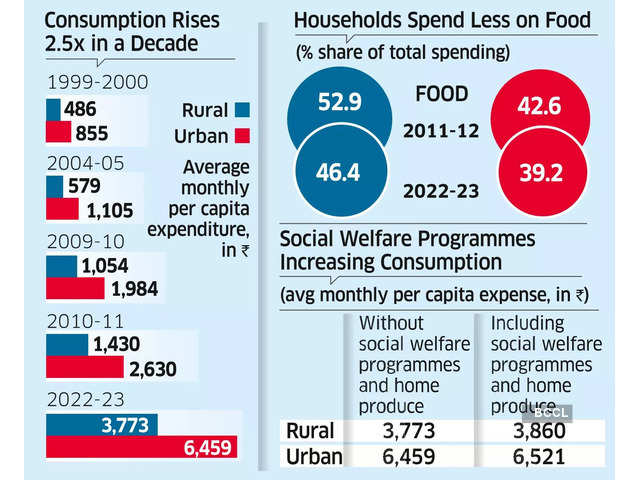
- The survey encompassed a significant sample size of 2.6 lakh households, with 1.5 lakh from rural areas and 1.1 lakh from urban areas, spanning from August 2022 to July 2023.
- In terms of Monthly Per Capita Consumption Expenditure (MPCE), rural areas recorded Rs. 3,773, while urban areas recorded Rs. 6,459 in 2022-23.
- Comparing these figures to the previous survey in 2011-12, rural MPCE has grown at a Compound Annual Growth Rate (CAGR) of 9.2%, whereas urban MPCE has grown at an annual rate of 8.5%.
- The survey also reveals a trend of households spending less on food compared to non-food items, with rural households allocating 46% to food and urban households allocating 39%.
Factors Influencing Changing Consumption Patterns
- The noticeable growth in rural consumption is somewhat surprising given recent sluggishness in rural economic growth.
- Potential explanations include the impact of social welfare schemes, which may have freed up funds earmarked for food, thereby increasing overall expenditure.
- Additionally, higher rural inflation compared to urban areas during the survey period likely contributed to increased expenditure among rural households.
Findings on Inequality
- While the consumption gap between rural and urban areas is decreasing, income inequality persists, resulting in higher spending among high-income earners.
- The percentage difference between rural and urban consumption relative to rural MPCE has decreased from 90.8% in 2004-05 to 71.2% in 2022-23, indicating improving incomes in rural areas.
Eating Habits in Rural and Urban India

- There is a noticeable shift towards processed foods, with beverages, refreshments, and processed foods comprising the largest share of food and drink consumption across India.
- Milk and milk products follow closely, with vegetables, eggs, fish, meat, and cereals also prominent.
- Notably, the share of expenditure on cereals has declined from 10.69% in 2011-12 to 4.89% in 2022-23 in rural India, while spending on vegetables has also decreased.
- Conversely, expenditure on processed foods has increased despite a decrease in total food spending as a percentage of total spending in rural India.
- Other categories with increased spending percentages in rural India include dry fruits, eggs, fish, meat, fruits, and milk and milk products.
- Theyyam Performance Art of Kerala

- Theyyam is traditional ritualistic performance art form indigenous to the northern region of Kerala.
- The art of Theyyam has a rich history, believed to have evolved over centuries. It encompasses elements of music, dance, and drama, primarily aimed at honoring various Hindu deities, notably Goddess Kali.
Noteworthy Characteristics:
1. Unique Setting: Theyyam performances are distinct in that they occur at village shrines or in joint-family homes rather than conventional stages.
2. Extended Duration: These performances are known for their lengthy duration, often spanning from 12 to 24 hours, highlighting their significance within the community.
3. Ritualistic Practices: During the event, the principal dancers reside near the shrine and observe fasting after sunset, adhering to traditional rituals.
4. Costumes and Masks: Theyyam is characterized by the use of vibrant masks and face paints, contributing to its visual allure.
5. Musical Ensemble: Accompanying the dancers are traditional Kerala instruments like the chenda, tuti, kuzhal, and veekni, adding depth and rhythm to the performance.
6. Choreographed Dance: The dance sequences, known as “Kalaasams,” follow a structured pattern, adding a layer of artistry to the proceedings.
7. Religious Influence: Certain customs within Theyyam, such as fasting after sunset, hint at religious influences from traditions like Jainism and Buddhism.
- Baleen Whales
Recently, scientists made a breakthrough in understanding the mechanism behind the mesmerizing vocalizations of baleen whales, such as humpbacks, which reverberate across vast expanses of the ocean.
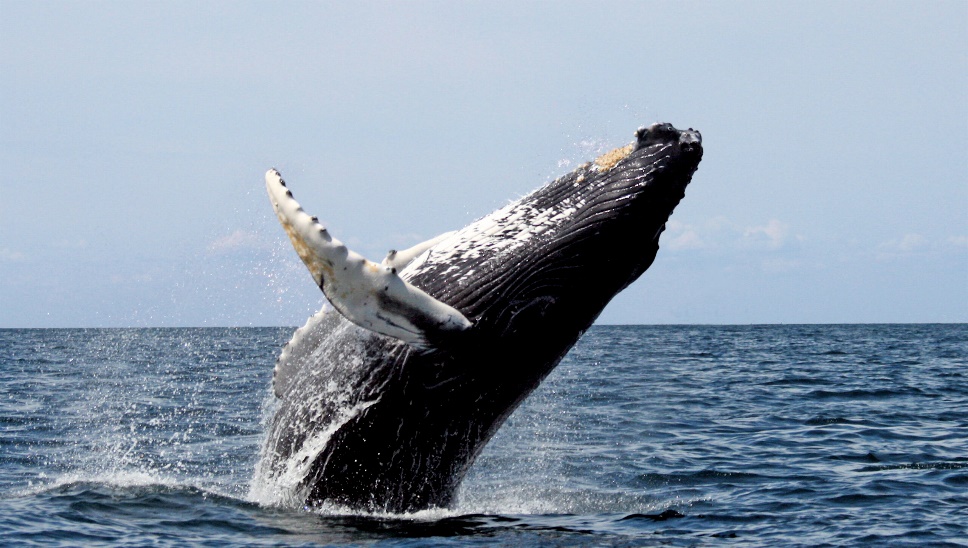
Key Points about Baleen Whales:
- Baleen whales, also referred to as whalebone whales, are significant marine mammals within the cetacean order.
- This group comprises 14 species, including notable ones like the Blue whale (the largest known animal on the planet), Humpback whale, Gray whale, fin whale, and Minke whale.
- Unlike most mammals, which possess teeth, baleen whales employ baleen, a large structure made of fine, hair-like keratin, to filter tiny krill from the water.
- The intricate vocalizations of baleen whales, often described as “songs,” serve vital functions in communication, mating rituals, and navigation across vast oceanic expanses.
- While human speech relies on vocal folds within the larynx (vocal cords) supported by small cartilage structures called arytenoids, baleen whales possess large and rigid arytenoids, which form a ring pressing against the laryngeal cushion, thereby producing sounds as the whale exhales.
- All species of baleen whales are classified under CITES Appendix I, denoting the most endangered category among CITES-listed animals and plants.


